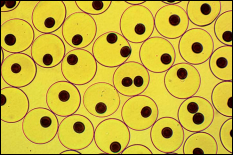News Story
Biomimetic Multi-compartment Capsule Invention May Help Scientists Understand the Origins of Life

Optical micrographs of a population of MCCs having mostly one or two (identical) internal compartments.
For centuries the origin of life has fascinated great minds in art, literature, and science who have brought us masterpieces such as Michelangelo’s "The Creation of Adam" and Mary Shelley’s "Frankenstein," as well as foundational scientific achievements like Darwin’s theory of evolution. Over time, we have come to understand more about where life comes from and how it evolves, but the answer to the most fundamental question still eludes us. How does something go from being a collection of non-living chemicals to a living being?
This is the question that has inspired University of Maryland (UMD) researchers Professor Srinivasa Raghavan and his former student Hyuntaek Oh (Ph.D. ’14) to invent a new method for synthesizing multi-compartment capsules (MCCs) with distinct internal compartments, each having unique properties.
Raghavan and Oh were inspired by the structure of biological cells such as those in humans, which all have smaller compartments (called organelles) in them. Accordingly, they set forth to build capsules (based on materials called biopolymers) smaller capsules inside them. The inner capsules can hold any biological substance, including nanoparticles, drugs, proteins, enzymes, microbial organisms, and mammalian cells. Researchers have made similar MCCs before by manufacturing their own chemicals and emulsifying the blend for their creation, but the process is time-consuming and there are limits to what can be put in the capsules. Raghavan and Oh, however, have invented a method to make capsules that only takes an hour from start to finish and uses water-soluble chemicals that are readily available for purchase.
“The simplicity of our method to make MCCs is what makes our invention unique,” said Raghavan. “The fact that we can mix and match many different compartments within the same MCC makes it much more versatile as well.”
The team’s MCCs have the potential to be used in a variety of applications, the most obvious being drug delivery and biochemical studies. For example, they could put multiple kinds of bacteria in the compartments along with an antibiotic to observe how they react. However, the potential to understand how nature evolves from non-living chemicals to living cells could potentially be the most impactful element of the invention.
“Our MCCs are a platform through which we can ask and answer profound questions about the nature of life,” said Raghavan. “By putting different kinds of biological materials in the capsules, we can experiment with creating hybrid forms of life…and eventually, we can perhaps gain insight into how life is created from the bottom up.”
The team is from UMD’s A. James Clark School of Engineering; Oh earned his Ph.D. from the Department of Chemical and Biomolecular Engineering in 2014, and Raghavan is the Patrick and Marguerite Sung Professor of Chemical Engineering.
The new method for synthesizing multi-compartment capsules with distinct components in each internal compartment has been nominated for the Invention of the Year award in the life sciences category, for which the winners will be announced at the 2018 Innovate Maryland celebration on April 11.
More information about the team’s research can be found in their article published in Chemical Science: "A New Design for an Artificial Cell: Polymer Microcapsules With Addressable Inner Compartments That Can Harbor Biomolecules, Colloids or Microbial Species"
Learn more about Innovate Maryland and the Invention of the Year Award nominees.
Published April 3, 2018









